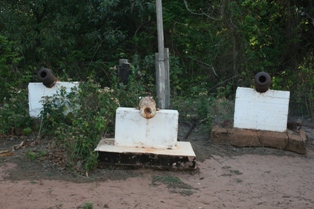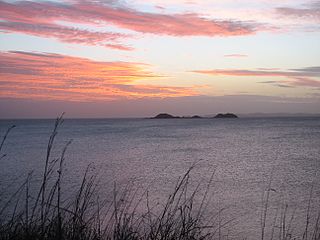Notes and references
Notes
- 1 2 Greer, McIntyre-Tamwoy & Henry 2011, p. 2.
- ↑ Greer, McIntyre-Tamwoy & Henry 2011, p. 8.
- ↑ Y192 Andooyomo at the Australian Indigenous Languages Database, Australian Institute of Aboriginal and Torres Strait Islander Studies
- ↑ Moore 1979, pp. 259–260.
Related Research Articles
Australia legally has no official language. However, English is by far the most commonly spoken and has been entrenched as the de facto national language since European settlement. Australian English is a major variety of the English language with a distinctive pronunciation and lexicon, and differs slightly from other varieties of English in grammar and spelling. General Australian serves as the standard dialect.

Somerset is a coastal locality split between the Shire of Torres and the Northern Peninsula Area Region, Queensland, Australia. In the 2016 census, Somerset had a population of 0 people.
Kuku-Thaypan is an extinct Paman language spoken on the southwestern part of the Cape York Peninsula, Queensland in Australia, by the Kuku-Thaypan people. The language was sometimes called Alaya or Awu Alaya. Koko-Rarmul may have been a dialect, though Bowern (2012) lists Gugu-Rarmul and Kuku-Thaypan as separate languages. The last native speaker, Tommy George, died on 29 July 2016 in Cooktown Hospital.

Albany Island or Pabaju is an island off the north-eastern coast of Cape York Peninsula in the Adolphus Channel and part of the Manar Group of islands of Queensland, Australia. It is within the locality of Somerset in the Shire of Torres.
Urradhi is a Paman language of the Cape York Peninsula of Queensland, Australia, and is apparently extinct. It was spoken by the Urradhi people. Urradhi proper is the south-western dialect of the language. The name is composed of urra "this" and the proprietive dhi "having". The south-eastern dialect of the same language, Wudhadhi, is made of the same elements, wudha being "this". These are part of a group of closely related and highly mutually intelligible dialects, these being Angkamuthi to the north of Urradhi, Atampaya inland from these, Utudhanamu inland north from Atampaya, Yantaykenu further north, being the language of the Bamaga area, Yadhaykenu on the east coast north of Wudhadhi, and Yaraytyana further north again. This group has no common language name, though Urradhi is commonly used as a cover name. It is unknown when it became extinct.

The Djagaraga or Gudang are an Australian Aboriginal tribe, traditionally lived in the coastal area from Cape York to Fly point, including also Pabaju, in the Cape York Peninsula, Queensland. In the early period of white settlement as the Somerset tribe, after the settlement of Somerset established on their lands in 1863.
Wambaya is a Non-Pama-Nyungan West Barkly Australian language of the Mirndi language group that is spoken in the Barkly Tableland of the Northern Territory, Australia. Wambaya and the other members of the West Barkly languages are somewhat unusual in that they are suffixing languages, unlike most Non-Pama-Nyungan languages which are prefixing.

The Australian National Aboriginal and Torres Strait Islander Education Policy (AEP) is a national policy adopted by the Government of Australia by each State and Territory government. The policy was first introduced in 1989 and is the foundation of education programs for all Indigenous Australians.

The Paman languages are an Australian language family spoken on Cape York Peninsula, Queensland. First noted by Kenneth Hale, Paman is noteworthy for the profound phonological changes which have affected some of its descendants.

The Northern Peninsula Area Region is a local government area in Far North Queensland, Australia, covering areas on the northwestern coast of Cape York Peninsula. It was created in March 2008 out of three Aboriginal Shires and two autonomous Island Councils during a period of statewide local government reform. In June 2018, the area had a population of 3,069.
Kukatj, also rendered Gugadj, is an extinct Paman language of the Cape York Peninsula, Queensland, Australia. The name Kalibamu has also been assigned to it, although this may be a separate dialect. It is spoken by the Kukatj people. A single speaker was last recorded in 1975.
Mbariman-Gudhinma, one of several languages labelled Gugu Warra 'unintelligible speech' as opposed to Gugu Mini 'intelligible speech', is an extinct dialect cluster of Aboriginal Australian languages of the Cape York Peninsula in northern Queensland, Australia. Another one in the group is Wurangung, also known as Yadaneru or Jeteneru.
Mayi-Kutuna, also spelt Mayaguduna, Maikudunu and other variants, is an extinct Mayabic language once spoken by the Mayi-Kutuna, an Aboriginal Australian people of the present-day Cape York Peninsula in northern Queensland, Australia.

Kaurareg is the name for one of the Indigenous Australian groups collectively known as Torres Strait Islander peoples. They are lower Western Islanders, based on the Muralag group. In common with the other peoples of the Torres Strait Island, they commanded impressive sailing outrigger canoe technology, traded throughout the Straits, fishing and trading with other Torres Strait Island groups. Similarly, they also regularly visited the Australian mainland of Cape York Peninsula, and retained ceremonial, marriage and trading alliances with several Aboriginal Australian groups there. Subject to reprisals after being blamed for an incident in which a Western schooner and its crew were destroyed, their numbers rapidly diminished with the onset of white colonisation and administration. After World War II, descendants of the Kaurareg began to return to their traditional islands, and lay claim to native title over several of them.
The Gumakudin were an indigenous Aboriginal tribe of the Cape York Peninsula. They may have been a sub-clan of the Yadhaigana. They were decimated during the earlier period of colonisation of northern Queensland.
Badu people are an Indigenous Australian group of Torres Strait Island people based on the central-west Badu island.
The Kaantyu are an Indigenous Australian people of the Cape York Peninsula. They live in the area around the present day town of Coen. Most of their traditional tribal land has been taken over for cattle stations. Kaantju refers to the hook of the yuli, their word for woomera.
The Yadhaykenu, otherwise known as the Jathaikana or Yadhaigana, are an Australian aboriginal tribe of northern Queensland. The name appears to be an exonym from the Western and Central Torres Strait yadaigal "talkers, chatterers,people who speak a lot".

Umagico is a town and coastal locality in the Northern Peninsula Area Region, Queensland, Australia. In the 2016 census, Umagico had a population of 427 people.
The Ngathokudi (Ngadhugudi) were an indigenous Australian people of the state of Queensland. Their language was possibly a dialect of Uradhi.
References
- Greer, Shelley; McIntyre-Tamwoy, Susan; Henry, Rosita (2011). Sentinel Sites in a cosmo-political seascape (PDF). 7th International Small Islands Conference, Airlie Beach, Whitsundays. pp. 2–10. Archived from the original (PDF) on 31 October 2016.
- Moore, David R. (1979). Islanders and Aborigines at Cape York. Australian Institute of Aboriginal Studies. ISBN 978-0-855-75082-4.
- Sharp, Nonie (1992). Footprints Along the Cape York Sandbeaches. Aboriginal Studies Press. ISBN 978-0-855-75230-9.